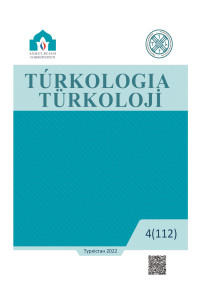MONGOLIAN MILITARY TERMINOLOGY IN ARABIC LETTER MULTILINGUAL DICTIONARIES
Keywords:
West Central Mongolian, Turkish, Vocabulary, Military TerminologyAbstract
As a result of the Mongol conquest movement that began in the 13th century, Mongolian was considered to be one of the “must-learn” languages of the time. As a result, Mongolian appeared in dictionaries from the period such as Mukaddimetü’l-Edeb, Kitâb Hilyetü’l-insân ve Helbetü’l-lisân (İbni Mühennâ ügati), Rasulid Hexaglot, Şâmilü’l-Luga ve Kitâb-ı Mecmû-ı Tercümân-ı Türkî ve Acemî ve Mugalî. This article identifies the military terminology included in the dictionaries in question’s Mongolian vocabulary and compares it to its Turkish equivalents to highlight similarities and contrasts between Western Central Mongolian and Turkish military terminology. In Mongolian dictionaries with Arabic letters, Mongolian war equipment names are mentioned as follows: bulau “mace, flail”, dūlγan “helmet”, hesi “sword pommel”, ildü “sword”, jida “bayonet”, kituγa “knife”, kögürge “drum”, moγodaq “blind sword; blind knife”, qalqan “shield”, qudqa “knife”, qui “scabbard”, ququ “knife”, quyaq “armor”, tuγ “tug, banner”. The words related to bows and archery, which are among the most significant war tools and equipment of the steppe peoples, are given in great detail in Mongolian dictionaries with Arabic letters. The words related to bows and archery, which are among the most significant war tools and equipment of the steppe peoples, are given in great detail in Mongolian dictionaries with Arabic letters. These words include: aqsau qurman “quiver belt”, bariūl “bow cover”, demiren “arrowhead”, erekebči “thumb ring”, kerčėsün “groove, notch”, kiriš “bowstring”, köbči “bowstring”, numun “bow”, ödün “empennage”, qodali “bone-tipped arrow”, qor “quiver”, qorumsaqa “quiver”, quldasun “bow dust”, sumun “arrow”. Among the words related to bow and archery, the words demiren “arrowhead” and kiriš “bowstring” are noteworthy in Turkish. Of these words, kiriš “bowsrting” is given together with the Mongolian synonym köbči “bowstring”. As a result, it is possible to say that Mongolian, which was particularly influential in the Mamluk-Ilkhanid areas, both affectedTurkish and was influenced by Turkish in the 13th-14th centuries, particularly in terms of military terminology.
References
Gül, Bülent (2015). Orta Asya’dan Anadolu’ya Moğol Yayılımının Dilsel Sonuçları. Türkbilig, Sayı 2015/30: 187–200.
Poppe, Nicholas (2016), Moğol Yazı Dilinin Grameri (Çev. Günay Karaağaç), Ankara: TDK Yayınları.
İm → Kilisli Rıfat (1340) [1922]. Kitâb Hilyetü’l-insân ve Helbetü’l-lisân. İstanbul.
Tmen → Gerhard Doerfer, (1963-1975), Türkische und mongolische Elemente im Neupersischen I-IV, Akademie der Wissenschaften und der Literatur, Veröffentlichungen der orientalischen Kommission 19, Wiesbaden.
Ed → Clauson, Gerard (1972), An Etymological Dictionary of Pre-Thirteenth-Century Turkish, Oxford.
Mhhtb → Çoımaa, Ş. ve diğerleri. (2006). Mongol Helnii Helzüin Toli, 1-2 Cilt. Ulaanbaatar.
Tsevel, Ya. (1966). Mongol Helnii Tovç Tailbar Toli. Ulaanbaatar.
Me → Poppe, Nicholas (1938). Mongol’skii Slovar’ Muqaddimat al-Adab. Çast I-II, Moskva-Leningrad.
KS → The King’s Dictionary: The Rasulid Hexaglot: Fourteenth Century Vocabularies in Arabic, Persian, Turkic, Greek, Armenian and Mongol. (2000). Translated by: T. Halasi Kun, Peter B. Golden, L. Ligeti and E. Schütz with essays by Peter B. Golden and Thomas A. Alsen. Leiden-Boston-Köln: Brill.
Lessıng, Ferdinand D. (1966), Mongolian-English Dictionary. Berkeley and Los Angels: University of California Press.
Mutçalı, Serdar (1995). Arapça-Türkçe Sözlük. İstanbul: Dağarcık Yayınları.
Rachewiltz, Igor De (1972). Index to The Secret History of The Mongols. Bloomington: Indiana University.
Melıoranskıy, Platon Mihayloviç (1903). Arab’ Filolog’ o mongolskom’ Yazık’. Tipografia imperatorskoy akademii nauk’.Sanktpeterburg’.
Lessıng, Ferdinand D. (2003), Moğolca-Türkçe Sözlük I-II (Çev. Günay Karaağaç), TDK Yay., Ankara.
KMo.: Klasik Moğolca
MMo.: Modern Moğolca
Schönig, Claus (2000), Mongolische Lehnwörter im Westoghusischen, Wiesbaden: Harrassowitz Verlag.
Lıgetı, Louis. (1962). Un Vocabulaire Mongol D’İstanboul. AOH. Vol. XIV, No 1: 3-99.
Şam. → SAITÔ, Y. (2013). The Mongolian Words in the Quadrilingual Vocabulary Preserved in the Topkapı Palace Museum Library. Current Trends in Altaic Linguistics, Edited by. Kim Juwon and Ko Dongho: Altaic Society of Korea: 305-338.
Ter. → SAITÔ, Y. (2006). Kitâb Majmû’ Turjumân Turkî wa-‘ajamî wa-Muğalî: Text and Index. Kyôto.

